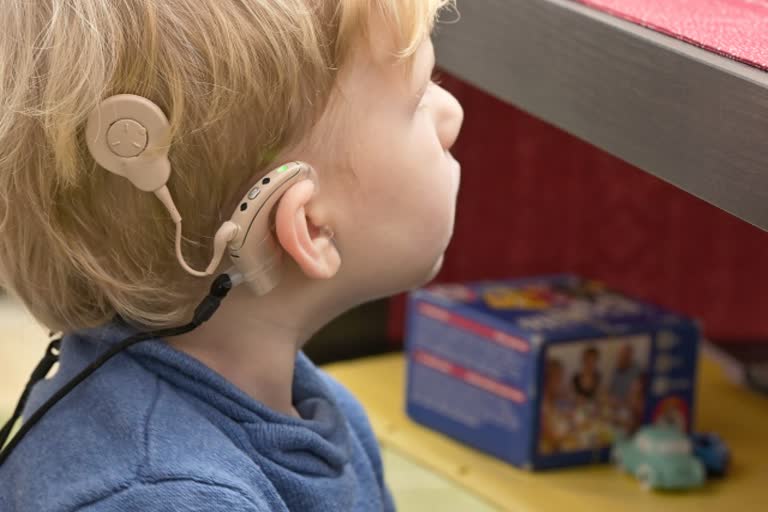The incidence of hearing loss in kids is 5-6% deafness per 1000. Out of which 1.25% suffer from profound deafness. If the kids can’t hear they can’t speak. Hearing deafness interferes with speech development. The kids generally need to undergo an Auto acoustic emission test, it's very routinely done in developed countries. In India also, this test is being done but it's yet to become widely popular.
Many private hospitals in India eg; Rainbow Hospitals, Hyderabad have facilities for performing this test. Soon after birth, is the right time to diagnose because we can provide them a hearing. Mild to moderate hearing loss if it is due to neural deafness, needs hearing aids. Out of 5-6 %, If they have severe deafness they need cochlear implants. Cochlear implantation can be done as early as 6 months of age, by doing this the child can get hearing by the time he or she is 2 years of age. Suppose if you delay this implant. Then it delays speech development.
Causes of hearing loss:
- If the mother has a history of German measles then the child is more likely to have deafness.
- -Consanguineous marriages, -8 to 9 out of 10 infants who undergo cochlear implants are born of consanguineous marriages.
- Family history of deafness.
- Use of ototoxic drugs (medicines that can damage the ear)
- viral infections during pregnancy
- Late pregnancies pose a high risk for Down’s syndrome and children with Down syndrome are prone to have hearing loss.
- Birth asphyxia (child did not cry at birth) or if the child has had a neonatal admission in NICU for more than 48 hours, Preterm babies –prone to have severe neonatal jaundice- prone to have hearing loss. Rh incompatibility also increases the risk of developing hearing loss.
- Certain antibiotics, given for neonatal medical conditions are known to be damaging to the ear.
- Measles, mumps, meningitis increase the risk of hearing loss.
- Up to 3-6 years of age, Adenoids or repeated nasal cold can lead to persistent gluey ear.
Children with mild to moderate hearing deafness benefit from a hearing aid but those with severe deafness need a cochlear implant.
How to diagnose this?
- An Otoacoustic emission (OEA) test is the screening test.
- Brainstem Evoked Response Audiometry (BERA) diagnoses the severity of hearing loss.
Also Read: Introduce Yoga To Kids For Better Concentration And Health.
How parents can identify deafness in children:
- If an object falls on the floor, the child turns its head, but here the Child does not turn in the direction of the sound.
- In the case of unilateral deafness, it is observed that the child turns a healthy ear in the direction of the noise often called a directional benefit. For this reason, doctor’s advise cochlear implants
In both ears or bilaterally. However, even if a cochlear implant is done even on one side, though directional benefit will occur the child will develop speech.
- Complaints from school.
- Ideally, cochlear implants should be done by the age of 3 years, if done beyond that, the speech quality won’t improve.
- Kids who undergo cochlear implants need to be given auditory Verbal Therapy (AVT) for one to two years. AVT is mistakenly referred to as speech therapy.
- Mild to moderate hearing generally goes undetected because they have frequent colds and they get gluey ears or Otitis media which causes conductive hearing loss. Adenoids or recurrent tonsillitis can also cause mild hearing loss in kids. conductive hearing loss usually gets better on its own, if not they need medical attention and impedance audiometry. Impedance audiometry will diagnose if the kid has a gluey ear.
Use of earphones:
- Now with online learning here to stay, parents realize kids cannot hear on one side. When using earphones, the volume should be minimal, if the child is exposed to more than 85 decibels (loud) for more than 8 hours can. Noise-Induced hearing loss (NIHL).
-Ideal to use speakerphone or headphone.
-Can cause a lot of crankiness, headache, irritability.
Auditory Hygiene tips:
- The ear canal has a self-cleaning property, it drives out the wax, if earbuds are used, it drives the wax deeper into the ear.
- Impacted wax- use wax softeners and then get it removed from the medical professional.
- Do not use oil in the ear- it can promote the growth of fungus.
- While Swimming, the use of earplugs is recommended and should get themselves treated before.
When to get an ear checkup done:
- At birth, the first year of life, 3-6 years if they get frequent respiratory viral infections.
For your queries, contact: vishnureddyn@hotmail.com



